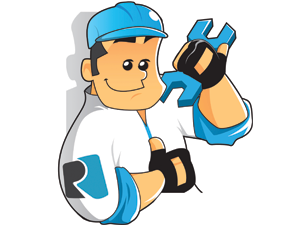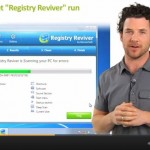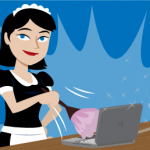MediaMonkey είναι μια μεγάλη εναλλακτική λύση στο iTunes για εκείνους που θέλουν να διαχειρίζονται MP3 players και μεγάλες συλλογές των μέσων μαζικής ενημέρωσης την ίδια στιγμή. Δώστε μια δοκιμή.
| Με Steve Horton |
|
|
| Με Steve Horton |
|
|
Το Windows Media Player ή το VLC Media Player; Έχουμε τρέξει κάτω τις διαφορές μεταξύ αυτών δημοφιλείς εφαρμογές βίντεο-παιχνίδι.
| Με Steve Horton |
|
|
Εδώ είναι μια μείωση των διαφόρων ασύρματων τεχνολογιών και μέγιστη ταχύτητα τους. 3G, 4G και Wi-Fi σε όλους τους έχουν διαφορετικά θεωρητικά όρια, και τα αποτελέσματα μπορεί να σας εκπλήξει.
| Με Steve Horton |
|
|
Υπήρξαν πολλά άρθρα συγκρίνοντας τις πιο πρόσφατες εκδόσεις των τριών πιο ισχυρά προγράμματα περιήγησης: Google Chrome 10, ο Internet Explorer 9 και Mozilla Firefox 4. Αλλά παίρνουμε μια διαφορετική προσέγγιση, καθώς στόχος μας είναι να σας βοηθήσουμε να βελτιστοποιήσετε την εμπειρία του browser σας. Θέλουμε να γνωρίζουμε ποιο πρόγραμμα περιήγησης χρησιμοποιεί λιγότερη CPU και λιγότερη μνήμη, ενώ τρέχει το ίδιο σύνολο των εργασιών.
| Με Steve Horton |
|
|
Τα αρχεία της Βοήθειας pop up κάθε φορά που κάνετε κλικ στο Help μέσα σε μια εφαρμογή. Είναι ιδιαίτεροι αρχείων στα Windows που είναι αποθηκευμένα ξεχωριστά, μακριά από την εφαρμογή. Αν το περιεχόμενο είναι γραμμένο από όποιον υπέβαλε την αίτηση, η διεπαφή του αρχείου βοήθειας είναι όλα τα Windows. Βοηθήστε τα αρχεία μπορεί να είναι ζωτικής σημασίας για την κατανόηση του πώς λειτουργεί μια πολύπλοκη εφαρμογή.
| Με Steve Horton |
|
|
Σε αυτό το διαδραστικό βίντεο, να μάθουν για το μητρώο των Windows και πώς Registry Reviver μπορεί να εξορθολογιστεί, βοηθώντας το PC σας τρέχει σαν καινούργιο.
| Με Steve Horton |
|
|
Ώρα να ξεσκονίσετε το PC σας, κυριολεκτικά και μεταφορικά, με αυτή τη σειρά από συμβουλές Καθαρισμός άνοιξη.
| Με Steve Horton |
|
|
YouTube είναι ένας πολύ καλός και εύκολος τρόπος για να επεξεργαστείτε δωρεάν βίντεο, χωρίς την ανάγκη για ακριβό λογισμικό επεξεργασίας βίντεο.
| Με Steve Horton |
|
|
Μια γραμματοσειρά είναι ένα άλλο όνομα για μια συγκεκριμένη γραμματοσειρά που χρησιμοποιεί ο υπολογιστής σας, όπως Arial, Helvetica, και ούτω καθεξής. Ένας υπολογιστής γεμάτο άκυρες καταχωρήσεις γραμματοσειράς στο μητρώο των Windows σας, χωρίς πραγματική αντίστοιχη γραμματοσειρά που είναι εγκατεστημένη, μπορεί να συντριβή συγκεκριμένες εφαρμογές.
| Με Steve Horton |
|
|
Αποθήκευση αρχείων πολυμέσων σας στο σύννεφο είναι μια καλή ιδέα, ειδικά αν έχετε ένα μικρό σκληρό δίσκο. Amazon Cloud Drive είναι ένας τρόπος να το κάνουμε αυτό.
| Με Steve Horton |
|
|
Για να κατανοήσουμε τους τύπους αρχείων, πρέπει πρώτα να κατανοήσουμε τις επεκτάσεις αρχείων. Τα τελευταία τρία με τέσσερα γράμματα σε ένα όνομα αρχείου μετά την περίοδο, όπως είναι. Doc ή. Docx, αντιπροσωπεύουν την επέκταση αρχείου. Κάθε επέκταση συνδέεται με έναν τύπο αρχείου. Σε αυτή την περίπτωση, ο τύπος αρχείου είναι έγγραφο του Microsoft Word. Κάθε εφαρμογή στον υπολογιστή σας έχει μια λίστα με τους τύπους αρχείων που συνδέονται με αυτό, και το μητρώο των Windows σας έχει ένα ρεκόρ αυτούς τους τύπους αρχείων.
| Με Steve Horton |
|
|
Φωτογραφία εφαρμογές οργάνωση μπορεί να είναι ακριβό και πολύ CPU έντασης. Είναι πολύ δύσκολο να ανεβάσετε και να οργανώσει πολλές φωτογραφίες σε ένα netbook, για παράδειγμα, επειδή οι δυνατότητες βίντεο ενός τέτοιου μηχανήματος απλά δεν μπορεί να χειριστεί μια εφαρμογή όπως το Photoshop. Επιπλέον, το λογισμικό διοργανώνει η φωτογραφία που περιλαμβάνεται στον υπολογιστή σας από τον κατασκευαστή δεν μπορεί να λειτουργήσει καλά σε όλα.
| Με Steve Horton |
|
|
Είναι σημαντικό να κρατήσει τους οδηγούς σας τόσο φρέσκα όσο θα μπορεί να είναι, και αυτό είναι όπου Reviver Driver μπαίνει Σε αυτό το διαδραστικό βίντεο, μάθετε πώς Reviver Driver εργάζεται για να κρατήσει τους οδηγούς σας ενημερωμένο.
| Με Steve Horton |
|
|
Έχουμε πάρει πολλές ερωτήσεις σχετικά με το τι Registry Reviver κοιτάζει όταν εκτελείται μια σάρωση του υπολογιστή σας, και πώς Registry Reviver κατατάσσει όταν ένα σφάλμα είναι παρούσα. Λόγω σε αυτές τις ερωτήσεις, γράφουμε μια σειρά από θέσεις blog που περιγράφουν όλες τις περιοχές του υπολογιστή σας που σαρώνει Registry Reviver, και γιατί οι περιοχές αυτές είναι σημαντικές για την υγεία του υπολογιστή σας. Τα άρθρα αυτά θα είναι γενικά περισσότερο τεχνικής φύσεως, αλλά σας συνιστούμε να ρωτήσετε οποιεσδήποτε ερωτήσεις στα σχόλια αν θα θέλατε κάτι εξήγησε.
| Με Steve Horton |
|
|
Στη δουλειά, είναι πιθανό να χρησιμοποιούν το Microsoft Outlook για να χειριστεί e-mail. Αν έχετε ένα παλιό μηχάνημα, και υπάρχουν ένα σωρό των παλαιών μηχανών εκεί έξω στον κόσμο των επιχειρήσεων, το Microsoft Outlook μπορεί να φάει μέχρι και έναν τόνο του επεξεργαστή του υπολογιστή σας! Είχα μια δουλειά φορά όπου δεν θα μπορούσατε να έχετε το Outlook ανοιχτό και κάτι άλλο ταυτόχρονα, ή ο υπολογιστής θα επιβραδυνθεί σε ένα crawl. Εκεί πήρε να είναι ένας άλλος τρόπος, ακόμη και για τους επιχειρηματικούς χρήστες.
περιηγηθείτε ανά κατηγορία
- Πως να χρησιμοποιήσετε το Battery Optimizer
- Πώς να χρησιμοποιήσετε Reviver Driver
- Πώς να χρησιμοποιήσετε το MacReviver
- Πώς να χρησιμοποιήσετε το PC Benchmark
- Πώς να χρησιμοποιήσετε το PC Reviver
- Πως να χρησιμοποιήσετε το Registry Reviver
- Πώς να χρησιμοποιήσετε το μενού Έναρξη Reviver
- Πρόσφατες Κριτικές
- ReviverSoft Απαντήσεις
- Δείτε Πιστοποιήσεις μας
- Πώς να καθορίσει μια μπλε οθόνη
- Πώς να καθορίσει τα Windows 7 προβλήματα οδήγησης
- Πώς να βελτιώσει την απόδοση του υπολογιστή σας
- Πώς να δούμε μετά από τον υπολογιστή σας
- Πώς να φροντίσει μπαταρία του φορητού υπολογιστή σας
- Πώς να επιδιορθώσετε μια δυσλειτουργία του υπολογιστή
- Μάθετε πώς να χρησιμοποιείτε τα Windows 7
- Windows Registry Insights
- Πώς να καθορίσει μια μπλε οθόνη
- Πώς να καθορίσει τα Windows 8 προβλήματα οδήγησης
- Πώς να βελτιώσει την απόδοση του υπολογιστή σας
- Πώς να δούμε μετά από τον υπολογιστή σας
- Πώς να φροντίσει μπαταρία του φορητού υπολογιστή σας
- Πώς να επιδιορθώσετε μια δυσλειτουργία του υπολογιστή
- Μάθετε πώς να χρησιμοποιείτε τα Windows 8
- Windows Registry Insights
- Πώς να καθορίσει μια μπλε οθόνη
- Πώς να διορθώσετε προβλήματα οδήγησης των Windows Vista
- Πώς να βελτιώσει την απόδοση του υπολογιστή σας
- Πώς να δούμε μετά από τον υπολογιστή σας
- Πώς να φροντίσει μπαταρία του φορητού υπολογιστή σας
- Πώς να επιδιορθώσετε μια δυσλειτουργία του υπολογιστή
- Μάθετε πώς να χρησιμοποιείτε τα Windows Vista
- Windows Registry Insights
- Πώς να καθορίσει μια μπλε οθόνη
- Πώς να διορθώσετε προβλήματα οδήγησης των Windows XP
- Πώς να βελτιώσει την απόδοση του υπολογιστή σας
- Πώς να δούμε μετά από τον υπολογιστή σας
- Πώς να φροντίσει μπαταρία του φορητού υπολογιστή σας
- Πώς να επιδιορθώσετε μια δυσλειτουργία του υπολογιστή
- Μάθετε πώς να χρησιμοποιείτε τα Windows XP
- Windows Registry Insights
Βίντεο Blogs
Δείτε όλα τα βίντεο Blogs →Πώς να είναι
Δείτε όλα τα Πώς να είναι →| most relevant |
| πρόσφατα άρθρα |
- Επιδιόρθωση μη λειτουργικής γραμμής αναζήτησης των Windows 11
- Επίλυση προβλημάτων ενημέρωσης των Windows 11
- Πώς να διορθώσετε την αργή εκκίνηση του συστήματος στα Windows 11
- Πώς να διορθώσετε τα πιο συνηθισμένα προβλήματα προγραμμάτων οδήγησης στα Windows 10
- Επιταχύνετε τον υπολογιστή σας με Windows 11









